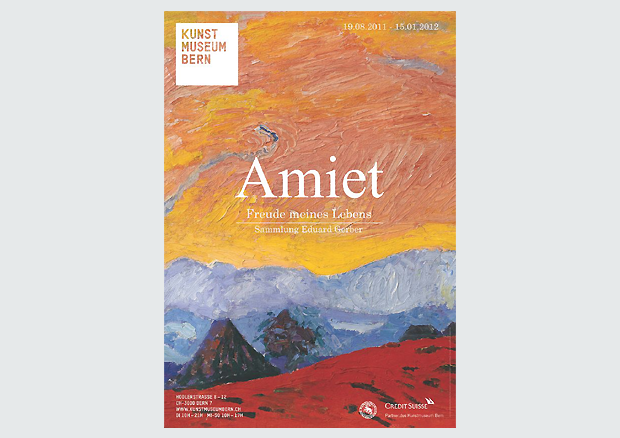Amiet. „Joy of My Live“, The Eduard Gerber Collection, Aug. 19, 2011 - Jan. 15, 2012
Amiet and the Collector of his Work
To commemorate the 50th anniversary of Cuno Amiet’s death, the Kunstmuseum Bern is presentinig the Eduard Gerber Collection, one of the most beautiful private collections of this artist’s work. Besides the collection of this great admirer of the artist we will also be showing works from the Kunstmuseum Bern representing Cuno Amiet’s "official" oeuvre. Thus the exhibition offers a representative overview of Amiet’s work.
Cuno Amiet (1868–1961) decided early in life to become a painter. 1884 he met Frank Buchser and became his student. After then studying in Munich – where he became friends with Giovanni Giacometti – and in Paris, Amiet moved to Pont-Aven in 1892. There he joined the artistic circle congregating around Paul Gauguin. Amiet also became acquainted with the Brücke painters in the circle of Ernst Ludwig Kirchner who are considered the pioneers of German expressionism. Back in Switzerland Amiet settled on the Oschwand in the canton of Bern in 1898. Far away from the great art centers of Europe he worked as an artist and asserted himself – next to Ferdinand Hodler who he was personally acquainted with – as a leading artist in Switzerland and a trailblazer of modern art. There are not many Swiss artists who mastered such a diverse oeuvre. Amiet’s pictures are marked by symbolism, Jugendstil, and also expressionism. This diversity of style evidences his internationality and his contact to many artist friends.
Emotional intimacy and great admiration
The private collection accrued by Eduard Gerber (1917–1995) comprises over one hundred works of the Bernese artist. The collection had its beginnings in the 1930s. In a fire Amiet lost over fifty of his early works that were exhibited in a retrospective in the Munich Glaspalast. Because of the catastrophe Eduard Gerber visited the already renowned artist. Over time not only a close friendship grew between the Amiet family and Eduard Gerber, but likewise one of the most beautiful private collections of Amiet’s work came into being. The artworks Gerber acquired each had a special significance at the time for the collector and the artist. Eduard Gerber’s collection was accrued over a long period of time and therefore boasts works from Amiet’s entire artistic career – from its very beginnings to his last creative phase. Eduard Gerber's collection is a testimony to the fact that it is not necessary to be enormously wealthy to establish an important art collection but that one must primarily have the necessary passion for art and connoisseurship.
A supplement of representative masterpieces
Whereas the Eduard Gerber Collection was built up on emotional intimacy with the artist, the Kunstmuseum Bern owns a representative group of Cuno Amiet's works that stand for the artist’s “official” oeuvre, underpinning his status as the new national artist after Ferdinand Hodler died. Cuno Amiet's works constitute one of the main emphases of the Kunstmuseum Bern’s collection: Its Amiet collection is both large and comprehensive with 56 paintings, 121 works on paper, as well as the sgraffito Apfelernte (Apple Harvest) on the façade of the museum building. The exhibition therefore offers a representative overview of the artist’s work. In Solothurn, where the artist was born, the Kunstmuseum Solothurn will be showing a comparative exhibition of works by Cuno Amiet and Ferdinand Hodler. With the title of Eine Künstlerfreundschaft zwischen Jugendstil und Moderne (Artist Friends between Jugendstil and Modernity)


